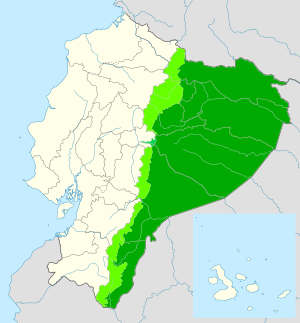Oriente (Ecuador) facts for kids
The Oriente (which means "East" in Spanish) is a special part of eastern Ecuador. It includes the eastern slopes of the Andes mountains and the flat, rainy rainforest areas of the Amazon basin. It's a place full of amazing nature and unique cultures.
Contents
Where is the Oriente?
The Oriente is located in the eastern part of Ecuador. To the north, it's bordered by the San Miguel and Putumayo rivers. To the east and south, it shares a border with Peru. This huge area covers about 130,000 square kilometers (about 50,000 square miles). Most of it is covered in thick tropical forest that hasn't been fully explored. Only a small number of people live here, mostly in small villages along the rivers.
The Oriente makes up almost half of Ecuador's land! But only about 5% of the country's people live there. While Ecuador has a Pacific coast and the Andes mountains (called the Sierra), the Oriente is all about its rivers. These rivers connect it to the huge Amazon basin and eventually to the Atlantic Ocean. Rivers like the muddy Río Napo are very wide and carry water from other rivers like the Coca and Aguarico, flowing into Peru. To the north, the Río Putumayo separates Ecuador from Colombia's Amazon region. Further south, the Río Pastaza and Rio Paute flow from Sangay National Park.
People and Life in the Oriente
Many people living in the Oriente are indigenous peoples. This means they are the original inhabitants of the land. It used to be hard for many people here to get an education. However, some Roman Catholic missions, like the Salesian missions, have helped by setting up schools.
What the Oriente Produces
The main natural resources found and used in the Oriente are timber (wood from trees) and petroleum (oil).
A Look at the Oriente's Past
The Incas, an ancient civilization, knew about the Quijos region (east of Coca) a long time ago. They would travel down from the mountains to meet the lowland tribes, sometimes in peace and sometimes for battle. The Spanish explorers were also the first Europeans to enter this area east of the Andes. Even today, people in jungle cities celebrate the anniversary of the European discovery of the Amazon River (February 12) with markets and fairs. Sadly, after Europeans arrived, many of the tens of thousands of local people died from diseases like smallpox and cholera.
A big change happened in the 1960s when oil was discovered. This made the Oriente, which was once a quiet, forgotten place, very important to Ecuador. In the northern part of the region, a large oil pipeline helps move the huge amounts of oil. This oil makes Ecuador the third-largest oil exporter in Latin America.
Across the Oriente, you'll find many places with names that come from the Quechua language. This shows the strong influence of the Lowland Quechua people, who live in the foothills and forests of western Napo and northern Pastaza provinces. In the north, there are also groups of Siona/Secoya and Cofán people. The Huaorani people have a very large protected area in central Napo province, which extends into Yasuní National Park. In the south, the Shuar and Achuar peoples' traditional lands were divided because of a long border dispute with Peru, which finally ended in 1998.
Fun Places to Visit
The Oriente has many exciting places to explore!
- Papallacta Hot Springs: These are natural hot springs located on the road from Quito. They are a great place to relax. The Piñan Lakes are also nearby.
- Napo Wildlife Center: This is one of the newest places to stay in the Ecuadorian Amazon. It's special because it's run by an indigenous community down the Río Napo.
- Tena: This city is a popular spot for white-water rafting and jungle tours. It's also easier to get to than many other cities in the Oriente.
- Zamora: About an hour and a half by bus from Loja, this town is in the southeastern part of the Oriente. It's one of the main entrances to the beautiful Podocarpus National Park.
Images for kids
See also
 In Spanish: Región Amazónica (Ecuador) para niños
In Spanish: Región Amazónica (Ecuador) para niños



